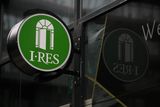Overheating risk as economic gap with North tipped to widen
Warning: Tom Healy, director of Neri which has said that the economic recovery has been uneven
The Irish economy is at "mild risk" of overheating this year and tipped for further growth, while in Northern Ireland slower growth is concentrated in part-time and temporary work.
The economic gap between both sides of the Border is to diverge further as Brexit looms, according to a report from the Nevin Economic Research Institute (Neri).
In the Republic, strong economic growth looks set to continue, according to Neri's all-Ireland Quarterly Economic Observer published today.
"The short-term outlook remains positive and we project real gross domestic product will grow 4pc in 2019," the think tank said of the Republic's economy using the working assumption of a so-called soft Brexit.
"The economy's cyclical upswing should continue out to the end of 2019 and the economy may be modestly overheating by that point," the trade-union affiliated body said.
It expects wages to rise, seeing average hourly earnings rising by 3pc this year and a robust 3.5pc in 2020 as domestic demand takes over from exports as the driver of economic growth.
The institute noted that even after years of economic growth in which the Republic has regularly topped the European Union charts, labour market performance "while improving, is merely average by EU standards".
While unemployment was at a 10-year low in the State and there were now record numbers of people in work, the recovery had been uneven, it said.
"For example, the rate of deprivation at 18.8pc, while declining, remains well above the pre-crisis rate of 11.8pc," the think tank said.
The latest data for Northern Ireland showed its economy grew by 2.1pc in the 12 months to the third quarter of last year, a relatively robust figure, although a closer look at the numbers paints a less optimistic picture.
Based on a rolling four quarter average which gives a better idea of the underlying direction of the economy, the annualised rate stood at just 0.5pc versus 1.6pc at the same period in 2017, Neri said.
"On current spending plans, day-to-day spending in Northern Ireland will have decreased to £9.9bn (€11.4bn) in real terms by 2019/20," the think tank said.
"Even if austerity ended this April, we would still be £600m below where we were in 2010."
While the economic recovery in the State has been uneven that in the North has seen a sharp shift to part-time and temporary work with fewer opportunities for progression and training.
According to Neri, the number of full-time jobs rose by 3,000 in the 12 months to the end of 2018. There was an increase of 22,000 in the number of part-time workers while the number of temporary workers rose by 10,000.
The outlook would be significantly worse in the event of a hard Brexit, Neri warned, noting that the gap between the performance of the two economies on the island would widen if trade and other direct links were broken.
Even in the best of circumstances, cross-border economic co-operation was more of a promise than reality, said Paul Mac Flynn, a senior economist at the think tank. "The potential that has been there was never realised," he said.
Join the Irish Independent WhatsApp channel
Stay up to date with all the latest news














